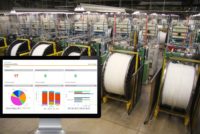
Armies of people make a living reading and interpreting standards. When a new standard is published, that “army” reads it carefully and then begins translating words into actions and evidence.
Besides the published guides and checklists that accompany each standard, a body of compliance evidence begins to emerge over time. This evidence is what the assessor expects to see when he audits a manufacturer.
When ISO/TS 16949:2002 was first published, registrars tasked with assessing companies to the standard had to satisfy several requirements. These requirements include training and examination of auditors.
Historically, the process and credentials an auditor must obtain to represent a registrar for assessments to QS-9000 Third Edition, and _now ISO/TS 16949:2002, have been consistent in format, content and toughness. A failure rate of 30% for those seeking accreditation as an assessor has been the industry norm. There have been many reasons why we see a higher attrition rate for automotive standards vs. ISO 9001:2000 assessor candidates. One often-cited reason is that the automotive-related standards tend to be more technically specific in content. Candidates without direct manufacturing or service knowledge, and some exposure to sound design and engineering practices, can find themselves at a distinct disadvantage when being accredited to technically driven standards.

Basics for the auditor and audited
A competent auditor must be able to assess a manufacturer’s standards-adherence system on its own merits and compliance to the standard, even if it takes the auditor out of his comfort zone. An auditor needs to understand the principals of design, manufacturing and service enough to pass judgment on the specific approach to compliance each manufacturer chooses. This is particularly important because of the process-oriented context of ISO/TS 16949. Many roads now lead to Rome, and an auditor better be competent to read the roadmap.Auditors, who must undergo training and take an exam, are provided with a checklist to use as they assess a company. The checklist contains examples of evidence to look for and definitions of common approaches to compliance. These examples and definitions are anecdotal, and they should not be used to draw a box around what can constitute evidence of compliance.
Over time, a body of conventional interpretations and evidence for determining compliance, coupled with the items in the checklist, emerges. This _evidence can be likened to the case law used by lawyers and judges for deciding matters of law. Examples of these conventional interpretations include audit checklists and training records. ISO/TS 16949 does not contain any blank form templates or finely detailed requirements, but the documentation of hundreds of companies reveals a common look and content. Individuals with the manufacturer being audited will swear that a form isn’t acceptable if it doesn’t contain specific phrases or layout sections. A look at what the standard requires usually reveals a _personal preference for a form on the part of a manufacturer or an assessor for particular phrases and layouts.
Manufacturers can become excessively concerned with tailoring their standards-adherence system to what they think the assessor is expecting to see rather than to what best fits customer and business needs. Managers create forms, reports and records that do not serve a single purpose in their businesses other than to be presented to an auditor each time he visits. Tough-minded men and women, who in the normal course of business have been known to reduce a vendor to tears, throw up their hands and refuse to argue with an auditor when it comes to standards registration.

Getting prepared
Auditor preparation is a subject for discussion among many long-time assessors, especially those who have been involved in quality since ISO 9001 was first used during the late 1980s.Time is one of the biggest challenges facing an auditor when a new standard _is released. There is a finite amount of time for the audit. Auditors spend many hours each evening reviewing notes of the specific requirements of the standard while trying to understand the manufacturer’s approach and ensuring that it is compliant.
Because the automotive industry is switching from QS-9000 to ISO/TS 16949, the auditor deals with a new “checklist.” The tendency for an auditor is to dig deep because the subject _matter is new and there is a desire to _be thorough.
With a new standard such as ISO/TS 16949, auditors often find themselves writing up more minor findings and observations. This is often a function of grasping the main idea of a standard but falling short on details and evidence.
Manufacturers often request that auditors be more than thorough and report how well the new requirements were understood and followed. Registered companies that have complained about how tough an auditor was during the original assessment will often request that same auditor when they are migrating to a new standard.
What to do with findings
When a manufacturer believes an auditor has made an error, and believes his standards-adherence system will hold up to scrutiny, the company should appeal. Steps that help a manufacturer avoid the need to appeal include:- Address each finding at the end of each day before the audit is concluded. Don’t wait for the final meeting.
- Make sure that the manufacturer and auditor understand each other. Findings can frequently be the result of misunderstandings.
- Always have the auditor go back to the relevant section of the standard and review the discrepancy in the context specific to the language of the standard.
Many manufacturers are struggling with the process-based focus of ISO 9001:2000 and ISO/TS 16949:2002. They are unsure about what processes should be documented and how. They question what the audits will look like because they are significantly different from the more familiar and element-based audits.
Manufacturers also struggle with _the customer satisfaction and resource competency requirements in the _standard. Process identification and definitions should include all of the processes that affect quality and _customer satisfaction. After these processes are known, the manufacturer then structures his audits around these processes.
For example, many manufacturers may believe the best way to measure customer satisfaction is through the use of a customer survey. With an average response rate of 6%, this tool can not _be the primary measure of the effect of processes on the product. Warranty activity, field returns and service-call metrics are far more stable indicators _of customer satisfaction and process importance.
ISO/TS 16949 provides manufacturers with the opportunity to reduce _documentation and develop a quality management system that reflects most business requirements. As for document reduction, many manufacturers consider it burdensome to revisit their documents as part of the process of migrating from QS-9000 to ISO/TS 16949. When ISO 9001:1994 and QS-9000 Third Edition were first enacted, many manufacturers tried to simply re-word existing documents for compliance by adding a phrase here and changing a paragraph there. It didn’t work.
Manufacturers should take the time to examine their manuals and documents as part of this standards transition. Manufacturers should get rid of what is no longer needed, consolidate where it makes sense and develop meaningful content.
Auditor “quality”
Auditors vary widely in individual experience and skills. Manufacturers need to be aware of this reality when selecting a registrar and an auditor. Registrars are no different from anyone else in the current economy. They are competing for business and trying not to lose their best, most experienced people to the private sector. During the late 1980s, there were less than 20 registrars who had their choice of a stable base of trained auditors with industry and field audit experience. Today, there are far more registrars who are competing for fewer highly trained auditors. Determine who the assessment team will be and request resumes. In using a consultant, don’t assume he or she is competent. Smart businessmen always do due diligence, check resumes and references, and require written proposals with a scope and timeline in advance. The businessmen should apply the same principles to updating a quality management system.Concerns that arise before, during or after the auditor’s visit should be discussed with the registrar. Defend the standards-adherence system in place and question findings when appropriate.
Many challenges face manufacturers who must transition to ISO/TS 16949 when it is mandated. Migration stra-tegies need to be discussed with a registrar soon. Under- standing what the registrar will want to see and how they expect to see it is key to a less stressful initial assessment visit.
Acknowledgements
The author would like to thank David Singer, ASQ-certified quality engineer and long-time lead assessor for several registrars, for his assistance with this story.Tech tips
- quality management system that reflects most business requirements.
- A competent auditor must be able to assess a manufacturer’s standards adherence-system on its own merits and compliance to the standard, even if it takes the auditor out of his comfort zone.
- Manufacturers should review their manuals and documents and get rid of what is no longer needed, consolidate where it makes sense and develop meaningful content.
- In transitioning to ISO/TS 16949, manufacturers should do due diligence, check resumes and references, and require written proposals with a scope and timeline in advance




